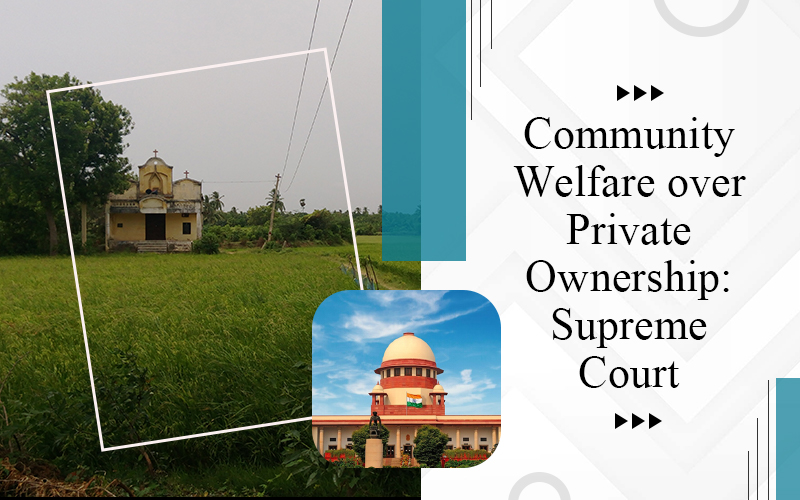State of Haryana v. Jai Singh & Others
Civil Appeal No. 6990 of 2014
(CJI BR GAVAI, PRASHANT KUMAR MISHRA, and K.V. VISWANATHAN, JJ)
The Supreme Court of India dealt with the constitutional validity of amendments made to the Punjab Village Common Lands (Regulation) Act, 1961, by Haryana Act No. 9 of 1992. The matter had originated in a Full Bench judgment of the Punjab and Haryana High Court, which had declared the amendment to be unconstitutional. The essence of the dispute was over the extent of “shamilat deh” or village common land, the rights of the owners of the lands who had put land forward at the time of consolidation, and the jurisdiction of the State to control such lands for communal purposes.
The history of the case runs back to a Government Gazette notification dated 11th February 1992, by virtue of which the Haryana Legislature added sub-clause (6) to Section 2(g) of the 1961 Act. This section, on being assented to by the President of India, extended the meaning of shamilat deh to cover land reserved for common purposes under Section 18 of the East Punjab Holdings (Consolidation and Prevention of Fragmentation) Act, 1948. The section also introduced an Explanation that lands which have been entered as “Jumla Malkan Wa Digar Haqdaran Arazi Hassab Rasad,” “Jumla Malkan,” or “Mushtarka Malkan” would also be covered under shamilat deh. Consequently, administration and control of such lands rested upon the Gram Panchayat under Section 23-A of the 1948 Act.
A number of proprietors and landowners who had made deposits in the common pool during consolidation objected to this amendment before the Punjab and Haryana High Court. They argued that the amendment illegally deprived them of ownership rights. Since the important questions of law involved and the common impact on village lands throughout Haryana, the case was sent to a Full Bench of the High Court. The High Court, on 18 January 1995, struck down the amendment, declaring it unconstitutional in Jai Singh and Others v. State of Haryana. This ruling was subsequently challenged by the State of Haryana before the Supreme Court.
The State of Haryana, in the court of the Supreme Court, contended that the amendment was a necessary step to secure communal village resources and ensure private appropriation of land meant for public use. The State reiterated that lands which fell under Jumla Malkan or Mushtarka Malkan classification were traditionally reserved for common use and not as private property. It was based upon precedent Supreme Court Constitution Bench decisions earlier, specifically in Bhagat Ram v. State of Punjab, Ajit Singh v. State of Punjab, and Ranjit Singh v. State of Punjab, where the same type of legislative provision had been upheld. The State also argued that the High Court had violated the doctrine of stare decisis and had incorrectly abandoned binding precedent.
Conversely, the owners of the land contended that the amendment forfeited their rights to ownership without reimbursement, contravening Article 14 and Article 300A of the Constitution. They asserted that such entries as Jumla Malkan in the record of rights did not represent common ownership but were expressions of private proprietorship involving minimum obligations. The petitioners maintained that the amendment unfairly took away their property and that the High Court was right in holding that it was unconstitutional. They also invoked previous High Court judgments like Gurjant Singh v. State of Punjab to justify their position.
The Supreme Court exercised careful examination of the issue. It began by revisiting Constitution Bench pronouncements in Ranjit Singh, Ajit Singh, and Bhagat Ram. In Ranjit Singh, the Court had observed that when lands were set apart for common purposes at the time of consolidation, they vested in the Gram Panchayat regardless of contribution by individual proprietors. In Ajit Singh, the Court had explained that proprietors’ rights in shamilat deh stood subordinate to community interests, and such lands were for common benefit. Likewise, in Bhagat Ram, reiterated was the fact that village common lands were intended for collective use and State action to control them was constitutionally valid. These precedents, according to the Supreme Court, had already established the legal position, and the High Court was mistaken in holding a different view.
The Court then considered the Full Bench judgment of the High Court. The High Court had argued that the amendment took over ownership from proprietors to Gram Panchayats without paying compensation, thus infringing on constitutional guarantees. The Supreme Court, however, held otherwise and ruled that the High Court had not accorded binding Constitution Bench judgments proper weight. The apex court held that once the lands were identified for common use under consolidation, the proprietors could not claim absolute ownership since their rights were always in the background as subject to community interest.
The fulcrum of the Court’s argument was its strong focus on the doctrine of stare decisis. The Court stated that judicial discipline necessitates the obligation of lower courts to adhere to binding precedents, especially the ones established by Constitution Benches. As the status of shamilat deh lands had already been finally settled by the Supreme Court in previous cases, the High Court was not correct in quashing the Haryana amendment. The doctrine of stare decisis was applied to ensure consistency, certainty, and stability in the legal system.
The Supreme Court ruled that the Haryana Act No. 9 of 1992 was valid and that the High Court judgment was wrong. The Court made it clear that lands under the categories of Jumla Malkan, Mushtarka Malkan, and such entries, after being reserved for village common purposes, vested in law in Gram Panchayats. Proprietary rights of individuals could not prevail over the community interest safeguarded by law. Consequently, the appeal filed by the State of Haryana was allowed.




